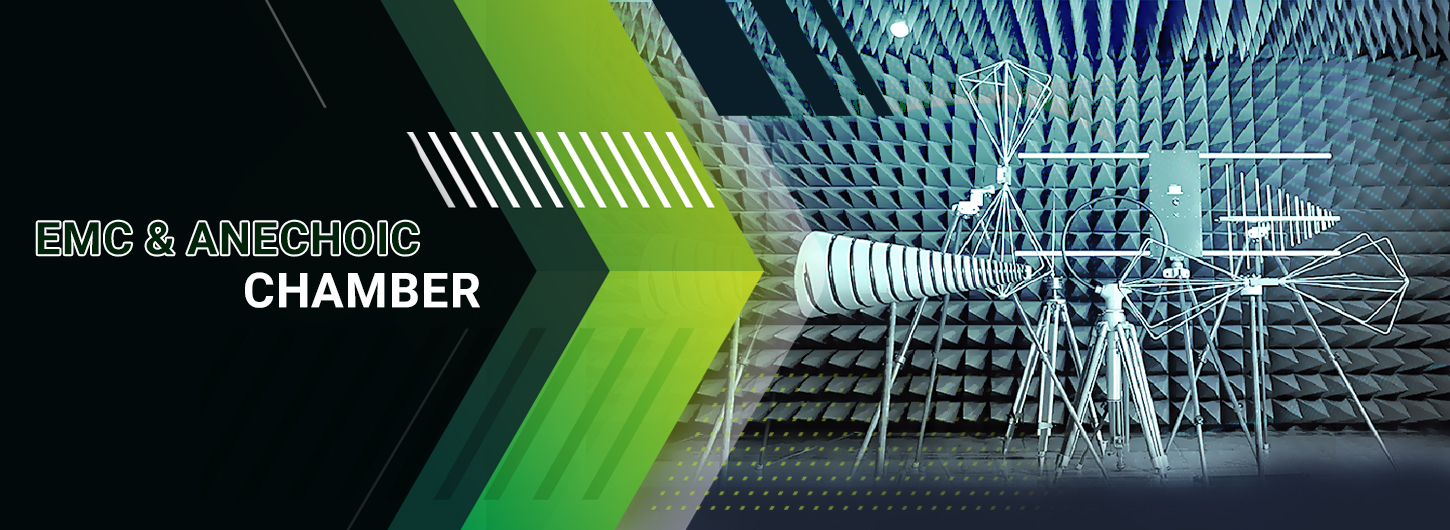
EMC & Anechoic chamber
An anechoic chamber is a RF protected room which walls and roof have been secured with Radiation Absorbent Material (RAM) that spreads or absorbs such a large amount of the incident energy that it can simulate free space. An anechoic chamber is simulating an Open Area Test Site (OATS), without interference from environmental electromagnetic field pollution. Testing can be conducted on full-scale objects including different electronic devices, vehicles, aircraft, spacecraft, or on scale models where the measurement radiation wavelength radiation is scaled in direct proportion to the target size.
An Anechoic chamber is utilized to measure antenna characterization, electromagnetic interference (EMI), and electromagnetic compatibility (EMC). Inside the chamber are absorbers that are designed with a variety of pyramidal items that steer the propagating incident field onto their neighboring absorbers. The chamber makes a virtual infinite space that has practically no interior reflections and will be safe from all undesirable external RF noises, by absorbing electromagnetic waves inside the chamber and hindering approaching signals from outside.
An anechoic chamber is a space that totally wipes out external noise so extremely exact measurements can be taken utilizing calibrated laboratory equipment. Originally these were intended for audible noise but the principles are the same for radio wavelengths .an EMI/EMC anechoic chamber suggests a significant investment. Various detailed considerations must be weighted in an anechoic chamber project. The screened room should be built to provide an atmosphere free of extraneous signals.
Anechoic chambers are categorized as "Semi Anechoic Chamber" or "Fully Anechoic Chamber", where latter has absorbers on every internal surface of the chamber.
EMC (Electromagnetic Compatibility) and anechoic chamber are two related concepts in the field of electrical engineering. Here's some information about each:
- Electromagnetic Compatibility (EMC): EMC refers to the ability of electronic devices, systems, and equipment to operate properly in their intended electromagnetic environment without causing electromagnetic interference (EMI) to other devices. It involves designing and testing products to ensure that they can function correctly while minimizing any negative impact on other nearby electronic devices.
Key aspects of EMC include:
- EMI: Electromagnetic interference occurs when electromagnetic emissions from one device disrupt the operation of another nearby device. EMC aims to reduce EMI and prevent interference problems.
- Emission: It involves controlling and limiting the unintentional electromagnetic emissions from devices, such as radio frequency interference (RFI) from electronic circuits, power lines, or cables.
- Immunity: Immunity refers to the ability of devices to withstand electromagnetic disturbances without experiencing malfunctions or performance degradation. It involves protecting devices from external electromagnetic fields or transients that could affect their operation.
EMC standards and regulations help ensure that electronic devices meet specific criteria regarding emissions and immunity. Compliance with EMC standards is crucial for manufacturers to obtain certifications and approvals for their products.
- Anechoic Chamber: An anechoic chamber is a specialized room designed to minimize reflections of sound or electromagnetic waves. It provides an environment with minimal echoes or reverberations, allowing accurate measurements and testing of antennas, wireless devices, electronic equipment, and other devices.
Key features and purposes of an anechoic chamber include:
- Absorbing Materials: The walls, floor, and ceiling of an anechoic chamber are covered with special materials, typically foam or pyramid-shaped structures, that absorb sound or electromagnetic waves. These materials absorb the waves instead of reflecting them, reducing echoes and reflections.
- Shielding: Anechoic chambers are often shielded to prevent external electromagnetic interference from entering the chamber and affecting measurements or tests.
- Antenna Testing: Anechoic chambers are commonly used to test and measure the performance of antennas. The absence of reflections allows accurate characterization of antenna radiation patterns, gain, and other parameters.
- EMC Testing: Anechoic chambers are also used for EMC testing. They provide a controlled environment for evaluating electromagnetic emissions and immunity of electronic devices without external interferences.
Anechoic chambers can be found in research institutions, engineering laboratories, and manufacturing facilities where precise measurements and testing of electromagnetic devices are required. They play a crucial role in ensuring the performance, quality, and compliance of electronic equipment with EMC standards.
